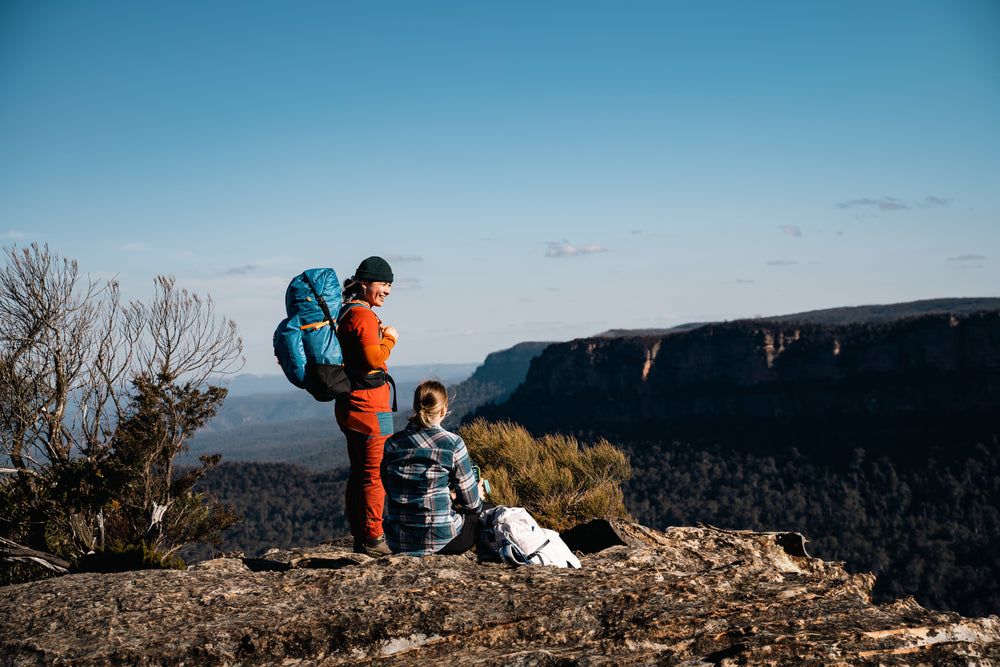Essentials Unpacked: What makes the Ultimate Pack?
Thinking about your first hiking pack or preparing for your next adventure? Read on to discover what makes the ultimate pack.
Back packs are an essential piece of equipment for every outdoor adventurer whether it’s a day hike to a local lookout or attempting to summit one of the largest mountains in the world. The question is, what makes for the ultimate pack. In my experience the most important question is - what is the activity that you are doing and has this pack been designed specifically for this activity? Using a generic pack can lead to unnecessary weight and complexity, reducing your performance and enjoyment.
Weight and Performance
Weight is critical to performance in outdoor activities. A lighter pack increases your chances of success and reduces the risk of injury. For example, studies show that for endurance hikes keeping your pack's base weight (weight of you pack without water and food) under 12 kg significantly improves performance in terms of kilometres covered per day and reduces injury risks. Also reducing you pack weight by 3.5kgs grams will make you 24 seconds a kilometre faster! Since the pack is a key component of the pack weight – starting by saving a few kilos on your pack itself, can make a big difference.
Features and benefits?
To me this can only be answered once it is clear what the purpose of pack is for? As a retailer of outdoor equipment, I see a lot of packs and more often than not I see complexity and features that may on the surface be attractive, but in reality, just add unnecessary weight. For example, if you are going into Alpine locations and scaling high peaks then ice axe loops and gear loops could be useful, but totally unnecessary for hiking the Camino trail. Likewise, I recently reviewed a pack that had a hood with an integrated day pack built in – this on the surface may seem like a selling point, however the day pack straps filled up the hood space, you had to carry it whether you needed a day pack or not and once you took the hood off the remaining pack looked very incomplete. The result was this pack had straps hanging off it everywhere and weighed 3 kgs! Remember simplicity is a feature, if you really need to have daypack for a particular trip then you can purchase an extremely light one that packs down to nothing and you can decide if and when to take it. The point is if you are clear about what it is that you need the pack to do, then look for those features and see others as just additional weight and complexity. There are some features that I think you should look for in just about any pack and they are:
- Lightweight: for all the reasons mentioned above.
- Waterproof materials and seam sealing: this reduces the need for additional items such as rain covers (that can be lost and add weight) and excess drybags (expensive).
- Accessibility: Being able to access key equipment without removing the pack e.g. ice axes for alpine conditions or drink bottles from the side pockets.
- Functional Pockets: that are easily accessible such as on the hip belt and shoulder straps make a lot of sense. Also avoid too many pockets other pockets that add weight and complexity under the guise of organisation.

- Glove friendly buckles: Useful in alpine and cold conditions.
- Load-Carrying Features: Such as pull forward hip belts, frames, load lifters and stabilisers – these all aid in transferring the weight to your hips and are essential.
- Minimal Pockets: Avoid packs with excessive pockets that add weight and complexity.
- Buckles over zippers: They fail less and are much easier to replace if they do break.
Prioritise comfort and load carrying ability
It is possible to make a pack too light. A well-designed pack will not only be light but have key load carrying features that distribute the weight to the correct locations so that you reduce your chance of injury and maximise comfort.
A framesheet and load lifters will assist in transferring weight onto your hips and stablise the load reducing fatigue and risk of injury. A pull forward hip belt is easier to tension and having the pack sit correctly on the hips is critical to carrying load well.

No two bodies are the same, and a one-size-fits-all approach to backpacks simply doesn’t cut it. You need a pack that is the correct size (waist and torso length) for your body. To accommodate this some packs are made in different sizes, whilst others have adjustable back lengths and hip belts. Just remember once a pack is fitted – you will probably never touch the adjustments again, but typically a pack that is adjustable will be a lot heavier than one that is built to size. Although most pack manufacturers position the adjustability as a key feature, the real driver for it is that it reduces the number of models required for mass production factories.
An Ultralight Yet Durable Material
The studies mentioned previously clearly show weight is a crucial factor for every hiking pack. But ultralight doesn’t mean you have to sacrifice durability. Advanced materials such as Ultra-High Molecular Weight Polyethylene (UHMWPE) and Dyneema utilise modern technologies to offer superior performance without compromising strength. Ultralight Packs are made from these super light materials, allowing you to shave approximately 1-2kg off your pack weight without sacrificing durability.
Stretch mesh is often used on packs for things like bottle holders, typically light nylon fabrics are used – the downside of this is they tear easily and once they are gone the pack functionality is really compromised. At Whippa we have selected a much more durable Ultra-stretch mesh with a UHMWPE weave through it to ensure that it can withstand the abuse for the lifetime of the pack.
Ventilated Back System: A Breath of Fresh Air or a Compromise?
Many hikers find the ventilated back system superior to other hiking packs. While they promise increased airflow, they might not be ideal for multi-day hikes since they transfer weight away from the back. Packs that sit closer to your back balance and disperse weight more effectively throughout your journey, minimising lower back and shoulder pressure, and thus increasing overall comfort.
Investment in Quality
Due to the cost of the materials, high quality ultralight packs are not cheap. week-long hike, you will be glad you spent that bit extra on the pack that suits you and means that your equipment is kilograms lighter than other setups.

From personal experience, I loved the experience of ultralight equipment when physically testing myself on epic adventures such as climbing the Matterhorn or hiking the Overland track. Never have I regretted the investment made and so many people that I met whilst doing these activities were heading off to get their own Ultralight pack after seeing and feeling the benefits of mine.

A Way Forward
Tailor your choice of a hiking pack to the specific requirements of your adventure. By focussing on the essentials and selecting an ultralight, purpose-built pack designed for the unique demands of your adventure will maximise performance and enhance the overall experience. When it comes to packs, weight and functionality are the two most important considerations. The aesthetics are a bonus! Remember - minimise the load on your back and achieve your ultimate adventure!
Written by Robert Inshaw (Owner and founder of Whippa and outdoor enthusiast) & Olivia Inshaw





